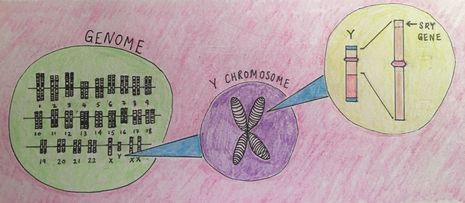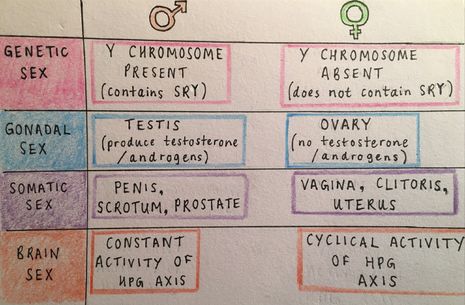Demystifying intersexuality
Rei Chin explores the biological basis for intersexuality, and highlights the need for acceptance

Intersexuality – you will most likely have heard of this term in the context of increasing LGBTQIA+ awareness; you may have heard of it in the context of sex testing in female sports. However, what does intersexuality or Differences in Sexual Differentiation (DSDs) mean? Society is increasingly striving towards inclusion and acceptance. Learning about what intersex individuals live with and how it arises may help us empathise with them. With this knowledge, we can also comprehend and contribute meaningfully to ethical and political debates about intersex rights.
The definition of sex is multi-faceted and consists of three components: genetic, gonadal and anatomic sex. Male genetic sex is defined as the possession of the Y chromosome, while female genetic sex is defined as the possession of only the X chromosome and not the Y chromosome; male gonadal sex is defined as the possession of testes while female gonadal sex is defined as the possession of ovaries; male anatomic sex is defined as the possession of male external genitalia such as penises while female anatomic sex is defined as the possession of female external genitalia such as vaginas. In most humans, the three components of sex will be aligned: females will inherit only X chromosomes, which means they develop ovaries and a vagina, with the opposite being true for males. However, intersex individuals possess a mixture of male and female traits. For example, their genetic and gonadal sex may be different to their anatomic sex; they can possess the Y chromosome and testes but have a vagina. Sex is therefore a biological trait and is different to gender, a personal choice of identification.
“Sex is therefore a biological trait and is different to gender, a personal choice of identification”
To understand intersexuality, we must first have a basic understanding of genetics. What is the relationship between DNA, genes and chromosomes? The human genome can be thought of as an enormous instruction manual for the creation of a functioning human. This manual is divided into a series of individual volumes. Each volume is composed of many chapters, and each chapter contains words. Similarly, the human genome is divided into chromosomes, which are analogous to the volumes. Each chromosome can be subdivided into many genes, the equivalent of chapters. Every individual gene, or chapter of the instruction manual, guides the formation of a different component of the human body. Genes are composed of DNA, just as the chapters of the instruction manual are composed of words.

There is a particular gene which determines the sex of the human being formed. It was named the SRY gene and can be found on the Y but not the X chromosome. In other words, the SRY ‘chapter’ is only found in the Y ‘volume’. At the early stages of development, all fetuses possess the same gonadal precursors, which will develop into either testes or ovaries depending on the presence or absence of the SRY gene. As a result, genetic sex directly influences the gonadal sex under normal circumstances.
The hormone testosterone is produced in the testes of male fetuses. It is an example of an androgen, though there are more potent androgens such as dihydrotestosterone (DHT). The physiological effects of androgens on the body are diverse: it can induce the building of muscle mass, increase the blood-carrying ability of blood, but more importantly, it stimulates the development of male external genitalia. Male and female fetuses initially share the same genital precursors such as the genital tubercle. However, these shared precursors later develop into male or female external genitalia depending on the presence or absence of androgens. For example, in the presence of androgens, the genital tubercle enlarges and becomes the penis in males; without androgens, the genital tubercle remains small and becomes the clitoris in females. It is worth noting that females also produce testosterone in organs such as the adrenal glands, albeit at a much lower level than men.
In summary, genetic sex directly influences gonadal sex, which then directly influences anatomic sex in the average human. However, exceptions to the norm are often found in biology. Intersex individuals have a mixture of male and female genetic, gonadal and anatomic sexual traits. Primary intersexuality is caused by variations at the level where genetic sex influences the development of gonadal sex. For example, SRY gene mutation may nullify its effects. These individuals effectively possess the Y ‘volume’ of the human genome instruction manual but have an erroneous SRY chapter. As a result, they do not have the correct instructions to develop male gonads. Consequently, they have male genetic sex but female gonadal and anatomic sex. In other individuals, the SRY chapter can be erroneously copied onto the X chromosome. As a result, they have female genetic sex but male gonadal and anatomic sex.

On the other hand, secondary intersexuality is caused by variations at the level where gonadal sex influences the development of anatomic sex via androgen signalling. Signalling consists of two parts: transmission and reception. For example, verbal communication depends on effective transmission of speech but also receptive hearing. Similarly, testosterone signalling depends on the production of testosterone by the testes or the adrenal glands, and also on the binding of testosterone to its cognate receptor at the target organ, such as muscle. Malfunctioning of signalling can occur at either the transmission or reception component.
In some secondary intersex conditions such as congenital adrenal hyperplasia, individuals with female genetic and gonadal sex produce excess testosterone in their adrenal glands. As a result, their external genitalia may somewhat resemble that of males. In other cases, individuals of the male genetic and gonadal sex may not be able to produce sufficient testosterone. As a result, their anatomic sex is more feminine. In one specific example known as 5α-reductase deficiency, individuals of the male genetic and gonadal sex fail to convert testosterone to the more potent androgen, DHT. As a result, they are born with female anatomic sex and are often raised as girls. However, at puberty, their testes mature and produce a vast amount of testosterone, which compensates for the deficiency in DHT. As a result, their external genitalia transform from feminine to masculine following puberty.
The reception of androgen signalling is equally important in sexual development. In cases of androgen insensitivity, mutations in the testosterone receptor result in decreased androgen signalling. As a result, those with male genetic and gonadal sex may have ambiguous or female anatomic sex. In the verbal communication analogy, this is akin to deafness – communication is poor when the receiver has difficulty hearing; the transmitter can speak louder to compensate, but this is not effective in cases where the receiver is profoundly deaf. Similarly, those with androgen insensitivity commonly have elevated levels of testosterone, but depending on the degree of insensitivity, the effect of testosterone may still be profoundly blunted.
“Intersex individuals were merely born with a biological variation, similar to the natural variations in hair colour, height and facial structure”
Intersex individuals often face discrimination and ostracisation in society due to ignorance. With more education about what intersexuality is and how it arises, microaggressions and stigmatisation can be minimised.cIntersex individuals were merely born with a biological variation, similar to the natural variations in hair colour, height and facial structure. Intersex rights organisations argue that the approach towards intersexuality as a medical condition is harmful to their community; they shun terms such as ’disorders of sexual differentiation’. Reconstructive surgery on intersex babies and children to ‘assign’ their sex has been common practice. Only recently has there been a shift in attitude towards the rights of the individual, who may choose to undergo surgery in later life or choose to accept their biological variation and remain as they are.
The legal classification of persons by sex is a deeply controversial topic. Some intersex individuals believe that they have the right to choose and change their legal sex. Some wish to be non-binary: sex is a spectrum with intersex individuals lying between the stereotypical males and females. Some believe that legal classification by sex should be abolished altogether.
Better understanding of the fundamental science behind intersexuality drives the intersex rights movement: it could lead to better policy-making as more members of society can contribute meaningfully to debates, and could contribute to destigmatisation. However, it is important to remember that intersex individuals are more than just their biological varations. Inclusion ultimately stems from acceptance that all individuals have the right to equal access, regardless of the underlying biology.
 Comment / Plastic pubs: the problem with Cambridge alehouses 5 January 2026
Comment / Plastic pubs: the problem with Cambridge alehouses 5 January 2026 News / Cambridge businesses concerned infrastructure delays will hurt growth5 January 2026
News / Cambridge businesses concerned infrastructure delays will hurt growth5 January 2026 News / New movement ‘Cambridge is Chopped’ launched to fight against hate crime7 January 2026
News / New movement ‘Cambridge is Chopped’ launched to fight against hate crime7 January 2026 News / AstraZeneca sues for £32 million over faulty construction at Cambridge Campus31 December 2025
News / AstraZeneca sues for £32 million over faulty construction at Cambridge Campus31 December 2025 News / Uni-linked firms rank among Cambridgeshire’s largest7 January 2026
News / Uni-linked firms rank among Cambridgeshire’s largest7 January 2026









